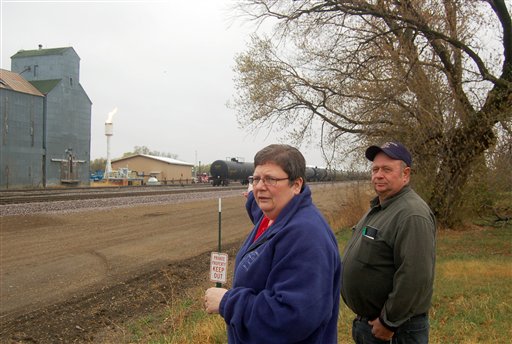(AP) Oil boom resurrects North Dakota ghost town
By JAMES MacPHERSON
Associated Press
DORE, N.D.
For more than three decades, Kerry and Darrell Finsaas were all that kept this blink-and-you-miss-it North Dakota community from becoming completely deserted.
As Dore’s only residents, they lived in a ghost town on the desolate northern Plains. But now the couple has neighbors _ and lots of them. The all-but-forgotten former farming village has been reborn as a hub of oil activity. And it may not be the last abandoned settlement to be resurrected from the dust.
Like many farm-dependent communities throughout the nation, Dore fell victim to changing agricultural practices and a harsh rural economy. By the early 1960s, the town on the state’s far western edge, near the confluence of the Yellowstone and Missouri rivers, was largely vacant. Most residents had either moved away or died.
One of the final blows came in the mid-1970s, when Dore lost its ZIP code. Since then, most surviving buildings have been leveled by bulldozers, weather and time. About all that remains is an empty grain elevator standing tall over the prairie _ a lonely memorial to earlier times.
These days, a century after its founding, the area is abuzz with development. Oil rigs drill in the distance, and mile-long tanker trains are topped off with crude here before heading to markets on the East, West and Gulf coasts. Dozens of campers and trailers have popped up on the nearby prairie, and hundreds more improvised dwellings are expected to take shape to house oil workers.
Dore’s economic and population turnaround began in 2008, when Houston-based Musket Corp. purchased land at the old town site for its oil loading facility, which uses railroad tracks that once moved grain and sugar beets to market.
Crude from North Dakota’s rich oil patch comes to the facility by truck and pipeline before leaving by rail. The company has been sending small shipments over the past two years but intends to raise production to 70,000 barrels a day this spring, Turner said.
The operation will employ about 45 workers, nearly equal to Dore’s population in its heyday.
At its zenith in the 1930s, Dore never had more than 50 or so residents, Kerry Finsaas said. But the town boasted a general store, a school, dance hall, bars, restaurants _ even a hat-making shop.
Harry “Bubba” Stelter moved to Dore this spring from Las Vegas, without ever knowing the town existed. No signs welcome visitors, and the name has been omitted from most maps.
Stelter, along with two business partners and their families, moved to the area in late March and opened a barbecue restaurant five miles away in Fairview, Mont.
The barbecue business is thriving, feeding workers from around the globe who have come to North Dakota’s oil patch for work, he said.
North Dakota, which had suffered decades of declining population, was the only state that lost residents in 2003, according to the Census Bureau. But since 2006, it has surpassed a half-dozen states to become the nation’s No. 3 oil producer. State officials estimate North Dakota will surpass Alaska and will trail only Texas within a year.
The state’s population is at record levels and its unemployment rate is the lowest in the nation, a turnaround attributed to the oil boom.
Merl Paaverud, superintendent of the State Historical Society of North Dakota, said other abandoned towns in the oil patch may come back to life.
For the Finsaases, the solitude and elbow room are gone from the once-quiet place where they raised three children.
Traffic along the two-lane highway that passes by their home has grown from a couple of vehicles an hour to hundreds. Waste gas from the rail-loading facility is flared a few hundred feet from the couple’s home, emitting a constant roar and an eerie glow that comes through their windows at night.
Kerry Finsaas grew up in Dore, but she and her husband now want to leave the commotion behind. They plan to move to a home just east of Fairview, on the North Dakota side of the border.
While purchasing a for-sale sign for their home at a Fairview hardware store, a man recently offered to buy the couple’s house without seeing it, said Darrell Finsaas, a retired utility worker.
The sale of their old home is pending, and the pair has already picked out a new house adjacent to a cemetery.

COMMENTS
Please let us know if you're having issues with commenting.